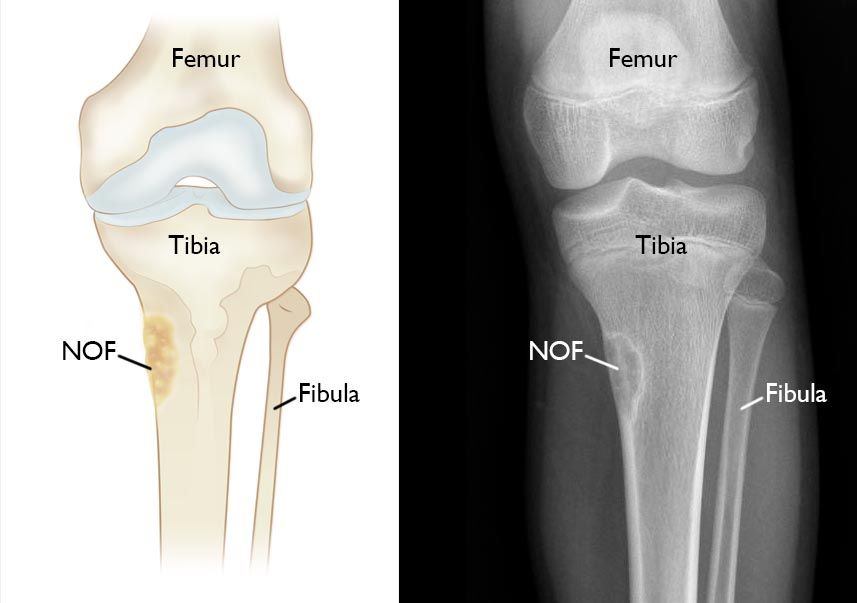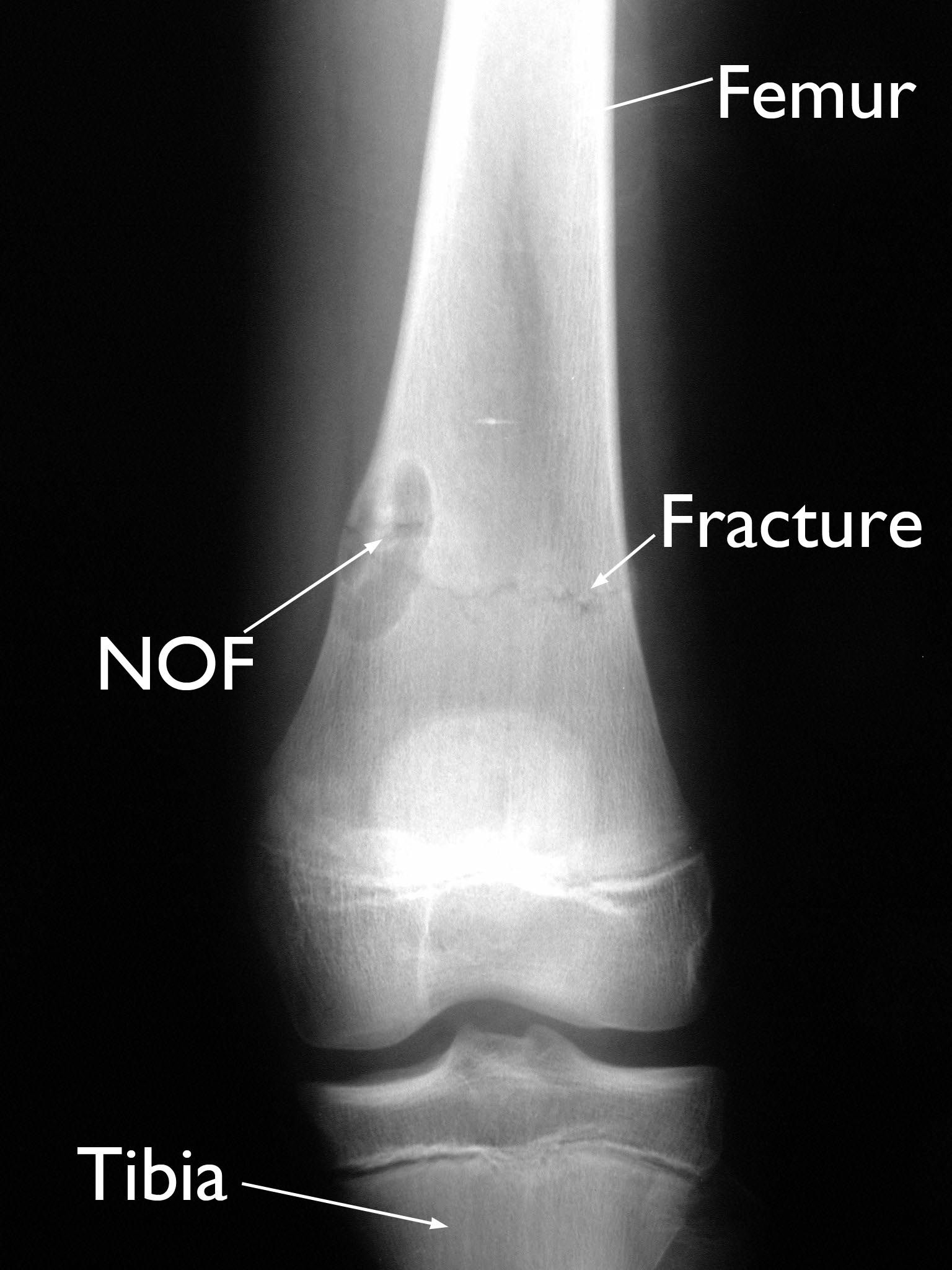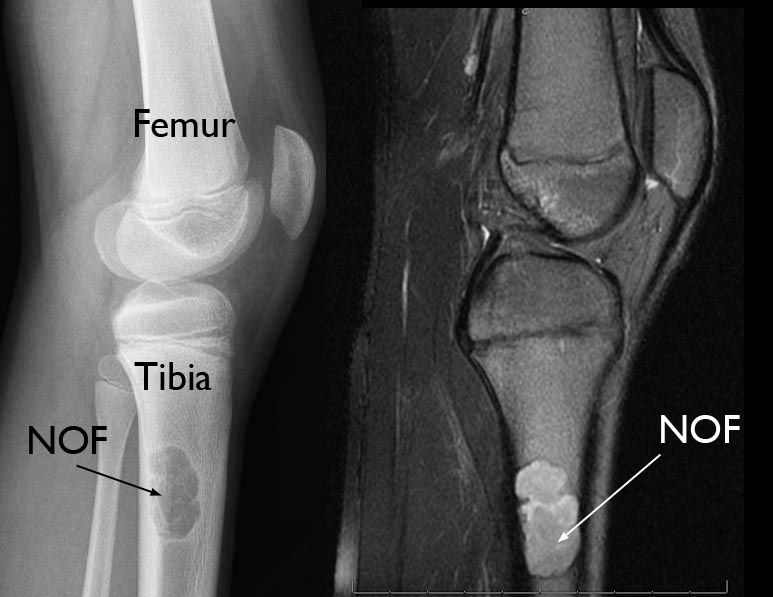Diseases & Conditions
Nonossifying Fibroma
Nonossifying fibromas (NOFs) are the most common benign (not cancerous) bone tumor in children. It is estimated that 30 to 40% of people under the age of 20 have an NOF, although few will have any symptoms. NOFs are often discovered by chance when a patient requires X-rays for another reason, such as a knee injury.
These tumors:
- Occur almost twice as often in males as in females
- Do not become cancerous
- Do not spread to other parts of the body (metastasize)
- Typically do not require treatment because most NOFs go away on their own when a child is fully grown
Description
Nonossifying fibromas are made of fibrous tissue and are typically yellow or brown in color. They most often occur in the flared end of the lower femur (thighbone) and in the flared upper or lower ends of the tibia (shinbone). NOFs also sometimes occur in the fibula (the smaller bone in the lower leg) and in the humerus (upper arm bone).
A small percentage of people with NOF will have more than one tumor. It is uncommon, however, to have more than two or three tumors except in certain very rare conditions (such as neurofibromatosis or Jaffe-Campanacci syndrome).
Nonossifying fibromas are also known as metaphyseal fibrous defects, fibrous cortical defects, non-osteogenic fibromas, fibroxanthomas, or cortical desmoids.
Cause
The cause of NOF is not known. There are no known factors that put you at greater risk for these tumors — such as genetics, the environment, or traumatic injury.
Symptoms
Most children with an NOF will have no symptoms at all. In many cases, the tumor is discovered incidentally (by chance) when the child has X-rays for another reason.
- Some patients will have mild swelling and tenderness to the touch over the NOF.
- A small percentage of patients will report a constant dull ache that is not associated with activity — meaning activity does not cause the ache to occur, and the ache does not go away when the child is at rest.
- Occasionally, patients will have pain with activity if the NOF is large and has caused the strong outer layer of bone (cortex) to be thinner. Pain may be due to the tumor itself or may be the result of a crack in the bone (pathologic fracture). These minor fractures can occur because an NOF weakens the overall strength of the bone. A fracture is more likely to occur when the NOF is large.
Doctor Examination
To diagnose an NOF, the doctor will take a complete medical history and conduct a physical examination. They will also order imaging tests — most important, X-rays.
Imaging Tests
X-rays. X-rays provide clear images of dense structures, such as bone. In an X-ray image, an NOF appears as a dark mass with a thin surrounding white rim.
Other imaging tests. In certain cases, a computerized tomography (CT) scan or magnetic resonance imaging (MRI) scan may be needed to further evaluate the tumor.
Although not always necessary, a CT or MRI scan can show the exact size of the tumor, as well as any change in its appearance over time. These images can also show cortical integrity (how thin the strong outer portion of the bone is in the region of the NOF) or a pathologic fracture.
At this time, there is no recommendation for whole body imaging to look for other tumors. Occasionally, the doctor will order a skeletal survey (series of X-rays) or a bone scan. If your child has pain in more than one bone, an X-ray is the best first step.
Treatment
Nonsurgical Treatment
Observation. In most cases, no treatment is needed for an NOF. Most often, doctors will observe these bone tumors over time with X-rays and physical exams. This surveillance may continue until the NOF has resolved (is no longer there).
Usually, NOFs stop growing when the adolescent finishes growing. Over time, the tumor will ossify (fill in with bone). An NOF will usually leave a "scar," or evidence the tumor was once there, even after it has filled with normal bone.
Surgical Treatment
In certain cases, surgical treatment should be considered. It is reasonable to consider surgical options if your child has:
- A large NOF
- Pain with activity
- A history of fracture through the NOF
Large size or the presence of symptoms can indicate that the bone is weak and likely to fracture, even with very little force (this is called a pathologic fracture). Surgery can help to remove the tumor and lower the risk of future fractures.
Curettage. This is the surgical procedure most commonly used to treat NOFs. In curettage, special instruments are used to scrape the tumor out of the bone.
Bone graft. After curettage, the doctor will fill the hole with a bone graft to help stabilize the bone. A bone graft may be taken either from a donor (allograft) or from another bone in the body (autograft). The doctor may also use a bone graft substitute or bone cement mixture to fill the hole.
Plate and screw fixation. In rare cases, the surgeon may need to support the bone with plates and screws to help stabilize it while the void (empty area) where the tumor was removed fills in with new bone. There might be options for other hardware and/or removal of hardware in the future.
Recovery
Most patients are able to return to full activity, including sports, by 3 to 6 months after surgery. Factors that may impact recovery time include:
- The size of the NOF
- The type of bone graft used
- How quickly the bone heals
Whether or not treatment was needed, most patients with an NOF should return to their doctor regularly for X-rays to make sure the tumor is not coming back or growing.
The long-term outlook for patients with NOF is very good. These tumors typically resolve spontaneously (go away on their own) once the child is finished growing, do not become cancerous, and rarely come back if treated surgically.
Contributed and/or Updated by
Peer-Reviewed by
AAOS does not endorse any treatments, procedures, products, or physicians referenced herein. This information is provided as an educational service and is not intended to serve as medical advice. Anyone seeking specific orthopaedic advice or assistance should consult his or her orthopaedic surgeon, or locate one in your area through the AAOS Find an Orthopaedist program on this website.









